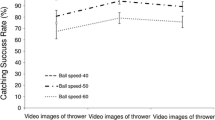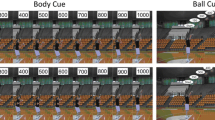Abstract
Studies of postural coordination during performance of externally-timed interceptive actions, such as catching a ball, have been infrequent, with advanced visual information from a thrower’s actions towards a catcher, typically excluded in experimental task constraints. Yet previous research suggests that manipulating participant access to such information alters their hand movements and gaze behaviours when catching. In this study, we manipulated participant access to advanced information of a thrower’s actions, and from ball flight, while recording whole body kinematic and kinetic data to investigate effects on postural control during performance of interceptive actions. Twelve participants attempted to make or simulate performance of one-handed catches in three experimental conditions: when facing integrated videos of advanced visual information and ball flight only, videos of a thrower’s actions only, and of ball flight only. Findings revealed when integrating advanced visual information and ball flight, and when participants were provided with ball flight information only, lower limb adjustments were primarily used to regulate posture. However, movement was initiated earlier when advanced visual information was available prior to ball flight, resulting in more controlled action and superior catching performance in the integrated condition. When advanced visual information was presented without ball flight, smaller displacements were observed in lower limb joint angles, resulting in upward projection of the centre of mass, compared to a downward trajectory when ball flight information was available, in the integrated video and ball flight, and ball-flight only conditions. Results revealed how postural coordination behaviors are dependent on specific informational constraints designed into experiments, implying that integration of task constraints in studies of human perception and action needs careful consideration.





Similar content being viewed by others
References
Abreu, A. M., Macaluso, E., Azevedo, R. T., Cesari, P., Urgesi, C., & Aglioti, S. M. (2012). Action anticipation beyond the action observation network: a functional magnetic resonance imaging study in expert basketball players. European Journal of Neuroscience, 35, 1646–1654.
Aglioti, S.M., Cesari, P., Romani, M., & Urgesi, C. (2008). Action anticipation and motor responses in elite basketball players. Nature neuroscience, 11, 1109–1116. doi:10.1038/nn.2182.
Aimola, F., Santello, M., La Grua, G., & Casabona, A. (2011). Anticipatory postural adjustments in reach-to-grasp: effect of object mass predictability. Neuroscience Letters, 502, 84–88. doi:10.1016/j.neulet.2011.07.027.
Angelakopoulos, G. T., Davids, K., Bennett, S. J., Tsorbatzoudis, H., & Grouios, G. (2005). Postural stability and hand preference as constraints on one-handed catching performance in children. Journal of Motor Behavior, 37, 377–385. doi:10.3200/JMBR.37.5.377-385.
Araújo, D., Davids, K., & Hristovski, R. (2006). The ecological dynamics of decision making in sport. Psychology of Sport and Exercise, 7, 653–676. doi:10.1016/j.psychsport.2006.07.002.
Barab, S. A., & Kirshner, D. (2001). Guest editors’ introduction: rethinking methodology in the learning sciences. The Journal of the Learning Sciences, 10, 5–15.
Bernstein, N. A. (1967). The control and regulation of movements. London: Pergamon Press.
Brunswik, E. (1956). Perception and the representative design of psychological experiments (2nd ed.). Berkeley: University of California Press.
Chan, J., Leung, H., Tang, J., & Komura, T. (2011). A virtual reality dance training system using motion capture technology. IEEE Transactions on Learning Technologies, 4, 187–195.
Chow, J. Y., Davids, K., Hristovski, R., Araújo, D., & Passos, P. (2011). Nonlinear pedagogy: learning design for self-organizing neurobiological systems. New Ideas in Psychology, 29, 189–200. doi:10.1016/j.newideapsych.2010.10.001.
Davids, K., Araújo, D., Vilar, L., Renshaw, I., & Pinder, R.A. (2013). An ecological dynamics approach to skill acquisition: Implications for development of talent in sport. Talent Development & Excellence, 5, 1–14.
Davids, K., Bennett, S. J., Kingsbury, D., Jolley, L., & Brain, T. (2000). Effects of postural constraints of children’s catching behavior. Research Quarterly for Exercise and Sport, 71, 69–73. doi:10.1080/02701367.2000.10608882.
Davids, K., Button, C., & Bennett, S. J. (2008). Dynamics of skill acquisition (pp. 1–251). Champaign: Human Kinetics Publishers.
Davids, K., Hristovski, R., Araújo, D., Balague-Serre, N., Button, C., & Passos, P. (2014). Complex systems in sport. London: Routledge.
de Lima, A. C., de Azevedo Neto, R. M., & Teixeira, L. A. (2010). On the functional integration between postural and supra-postural tasks on the basis of contextual cues and task constraint. Gait & Posture, 32, 615–618. doi:10.1016/j.gaitpost.2010.09.003.
Eckerle, J. J., Berg, W. P., & Ward, R. M. (2012). The effect of load uncertainty on anticipatory muscle activity in catching. Experimental Brain Research, 220, 311–318. doi:10.1007/s00221-012-3139-z.
Fink, P. W., Foo, P. S., & Warren, W. H. (2009). Catching flying balls in virtual reality: a critical test of the outfielder problem. Journal of Vision, 9, 1–8. doi:10.1167/9.13.14.
Gibson, J. J. (1979). The ecological approach to visual perception. Boston: Houghton-Mifflin.
Hommel, B. (2009). Action control according to TEC (theory of event coding). Psycholoigcal Research, 73, 512–526. doi:10.1007/s00426-009-0234-2.
Hommel, B., Müsseler, J., Aschersleben, G., & Prinza, W. (2001). The theory of event coding (TEC): a framework for perception and action planning. Behavioral and Brain Sciences, 24, 849–937.
Kazennikov, O. V., & Lipshits, M. I. (2010). Dependence of the anticipatory change in the grip force in the catching task on the result of the preceding trial. Human Physiology, 36, 370–381. doi:10.1134/SO362119710030205.
Kelso, J. S. (1995). Dynamic patterns: The self-organization of brain and behaviour. Cambridge: MIT.
Kelso, J. A. S., Buchanan, J. J., DeGuzman, G. C., & Ding, M. (1993). Spontaneous recruitment and annihilation of degrees of freedom in biological coordination. Physics Letters, 179, 364–371.
McRobert, A. P., Williams, A. M., Ward, P., & Eccles, D. W. (2009). Tracing the process of expertise in a simulated anticipation task. Ergonomics, 52, 474–483. doi:10.1080/00140130802707824.
Panchuk, D., Davids, K., Sakadjian, A., MacMahon, C., & Parington, L. (2013). Did you see that? Dissociating advanced visual information and ball flight constraints perception and action processes during one-handed catching. Acta Psychologica, 142, 394–401. doi:10.1016/j.actpsy.2013.01014.
Pinder, R. A., Davids, K., Renshaw, I., & Araújo, D. (2011). Representative learning design and functionality of research and practice in sport. Journal of Sport and Exercise Psychology, 33, 146–155.
Riccio, G. E., & Stoffregen, T. A. (1988). Affordances as constraints on the control of stance. Human Movement Science, 7, 265–300.
Riccio, G. E., & Stoffregen, T. A. (1991). An ecological theory of motion sickness and postural instability. Ecological Psychology, 3, 195–240.
Riley, M. A., Shockley, K., & Van Orden, G. (2012). Learning from the body about the mind. Topics in Cognitive Science, 4, 21–34.
Santos, M. J., Kanekar, N., & Aruin, A. S. (2010a). The role of anticipatory postural adjustments in compensatory control of posture: 1, electromyographic analysis. Journal of Electromyography and Kinesiology, 20, 388–397. doi:10.1016/j.jelekin.2010.01.002.
Santos, M. J., Kanekar, N., & Aruin, A. S. (2010b). The role of anticipatory postural adjustments in compensatory control of posture: 2. biomechanical analysis. Journal of Electromyography and Kinesiology, 20, 398–406. doi:10.1016/j.jelekin.2010.01.003.
Savelsbergh, G. J. P., Bennett, S. J., Angelakopoulos, G. T., & Davids, K. (2005). Perceptual-motor organization of children’s catching behaviour under different postural constraints. Neuroscience Letters, 373, 153–158. doi:10.1016/j.neulet.2004.10.011.
Savelsbergh, G. J. P., Whiting, H. T. A., Pijpers, J. R., & Van Santvoord, A. M. M. (1993). The visual guidance of catching. Experimental Brain Research, 93, 146–156.
Shiratori, T., & Latash, M. L. (2001). Anticipatory postural adjustments during load catching by standing subjects. Clinical Neurophysiology, 112, 1250–1265.
Stoffregen, T. A., Smart, L. J., Bardy, B. G., & Pagulayan, R. J. (1999). Postural stabilization of looking. Journal of Experimental Psychology: Human Perception and Performance, 25, 1641–1658.
Stone, J. A., Panchuk, D., Davids, K., North, J. S., Fairweather, I., & Maynard, I. W. (2013). An integrated ball flight-only technology for the study of dynamic interceptive actions. Behavior Research Methods,. doi:10.3758/s13428-013-0429-8.
Stone, J. A., Panchuk, D., Davids, K., North, J. S., & Maynard, I. W. (2014). Integrating advanced visual information with ball flight-only technology constrains dynamic interceptive actions. Procedia Engineering, 72, 156–161. doi:10.1016/j.proeng.2014.06.027.
Tijtgat, P., Bennett, S. J., Savelsbergh, G. J. P., De Clercq, D., & Lenoir, M. (2010). Advance knowledge effects on kinematics of one-handed catching. Experimental Brain Research, 201, 875–884. doi:10.1007/s00221-009-2102-0.
Tijtgat, P., Bennett, S. J., Savelsbergh, G. J. P., De Clercq, D., & Lenoir, M. (2011). To know or not to know: influence of explicit advance knowledge of occlusion on interceptive actions. Experimental Brain Research, 214, 483–490. doi:10.1007/s00221-011-2846-1.
Tijtgat, P., Vanrenterghem, J., Bennett, S. J., De Clercq, D., Savelsbergh, G. J. P., & Lenoir, M. (2012). Implicit advance knowledge effects on the interplay between arm movements and postural adjustments in catching. Neuroscience Letters, 518, 117–121. doi:10.1016/j.neulet.2012.04.066.
Tijtgat, P., Vanrenterghem, J., Bennett, S. J., De Clercq, D., Savelsbergh, G. J. P., & Lenoir, M. (2013). Postural adjustments in catching: on the interplay between segment stabilization and equilibrium control. Motor Control, 17, 48–61.
Tomeo, E., Cesari, P., Aglioti, S., & Urgesi, C. (2012). Fooling the kickers but not the goalkeepers: behavioral and neurophysiological correlates of fake action detection in soccer. Cerebral Cortex,. doi:10.1093/cercor/bhs279.
van der Kamp, J., Rivas, F., Doorn, H. V., & Savelsbergh, G. J. P. (2008). Ventral and dorsal system contributions to visual anticipation in fast ball sports. International Journal of Sport Psychology, 39, 100–130.
Vignais, N., Bideau, B., Craig, C., Brault, S., Multon, F., & Kulpa, R. (2009). Virtual environments for sport analysis: perception-action coupling in handball goalkeeping. The International Journal of Virtual Reality, 8, 43–48.
Warren, W. H. (2006). The dynamics of perception and action. Psychological Review, 113, 358–389.
Whiting, H. T. A. (1991). Action is not reaction! A reply to Mcleod and Jenkins. International Journal of Sport Psychology, 22, 296–302.
Williams, J. G., & McCririe, N. (1988). Control of arms and fingers during ball catching. Journal of Human Movement Studies, 14, 241–247.
Winter, D. A., Prince, F., Frank, J. S., Powell, C., & Zabjek, K. F. (1996). Unified theory regarding A/P and M/L balance in quiet stance. Journal of Neurophysiology, 77, 2334–2343.
Author information
Authors and Affiliations
Corresponding author
Rights and permissions
About this article
Cite this article
Stone, J.A., Maynard, I.W., North, J.S. et al. Emergent perception–action couplings regulate postural adjustments during performance of externally-timed dynamic interceptive actions. Psychological Research 79, 829–843 (2015). https://doi.org/10.1007/s00426-014-0613-1
Received:
Accepted:
Published:
Issue Date:
DOI: https://doi.org/10.1007/s00426-014-0613-1




